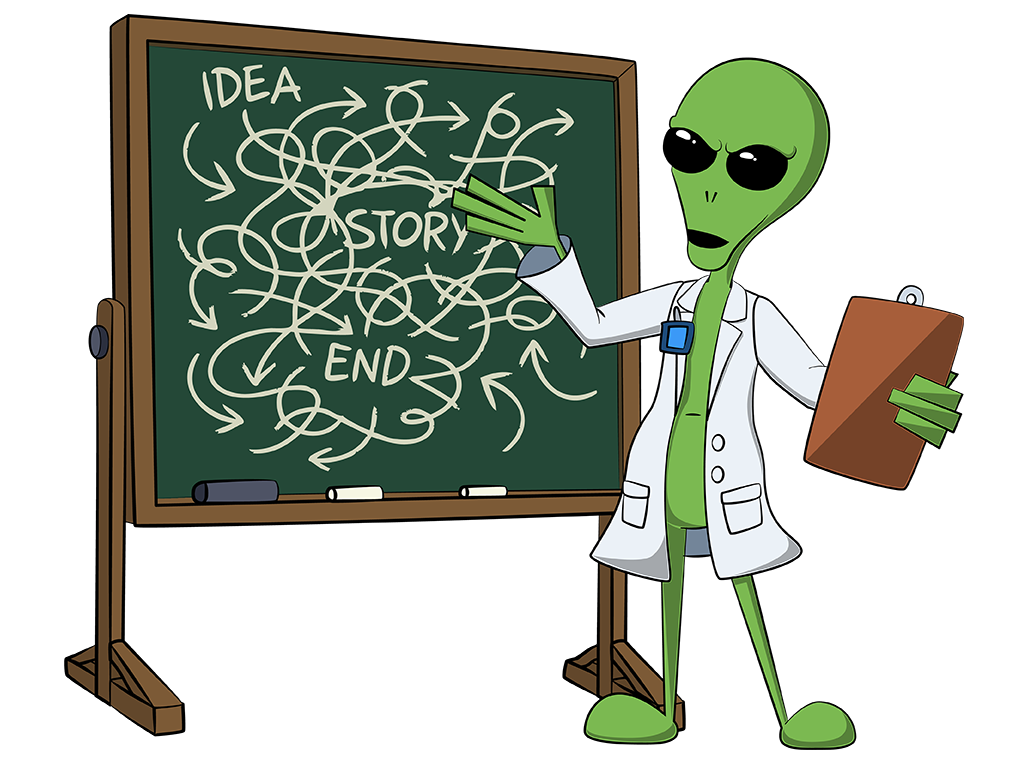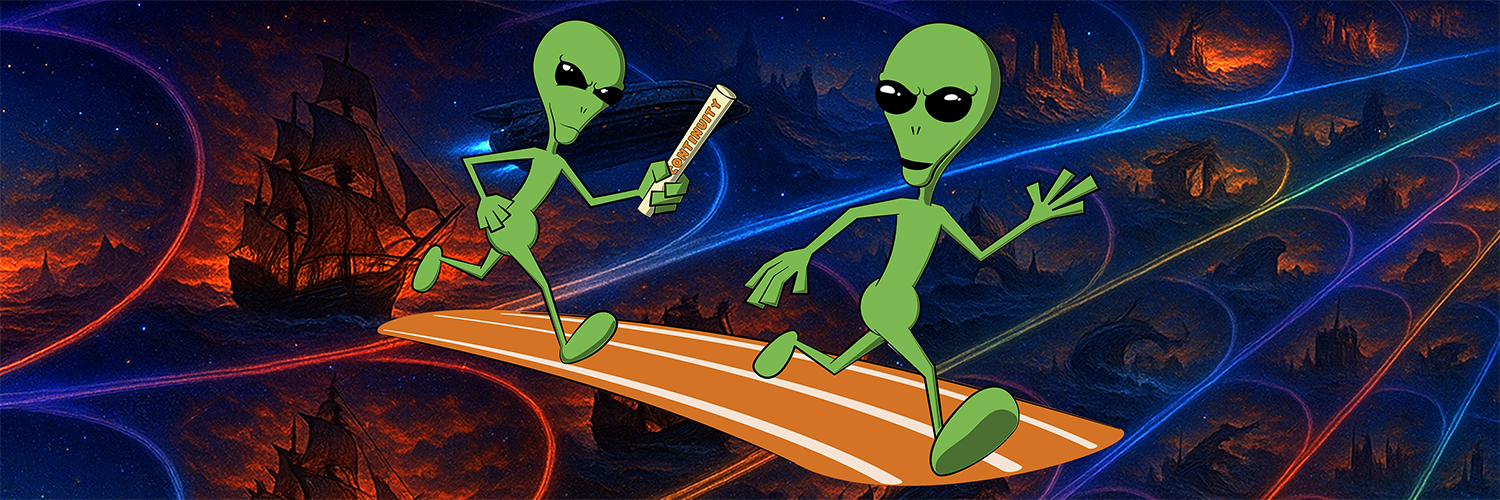Introducing continuity into Zeta Comic Generator with “Series” and “Notes“
Ever since I began sketching Alpha Zeta, the lanky four‑foot‑tall Reticulan, I’ve wanted his adventures to be an ongoing web‑comic. My biggest obstacle was building story momentum. Plot threads dissolved after one strip, inside jokes never evolved, and Alpha’s personality morphed like a glitchy holodeck.
I originally built the Zeta Comic Generator to outsource that writing hurdle to AI, letting the models handle the storytelling while I focused on the art. But, entertaining as the output is, each strip is a standalone joke. The archive reads like a scatter‑shot gag reel, not a cohesive saga.
The latest update to the Comic Generator takes a big step toward solving that problem: Introducing Series and Notes, the first phase of a broader initiative I call Continuity. If you’ve been following the Zeta Comic Generator (ZCG), this release turns it into something closer to a living narrative engine. Below, I’ll explain how it works, why I built it, and what’s coming next. A look from behind the curtain for fellow programmers and AI wranglers.
Series: Threading the Jokes
Each comic can now belong, optionally, to a Series. Think of a series as a narrative thread: “Alpha is a tech reporter,” “Alpha moonlights as a UFO historian,” “Alpha babysits a mischievous AI.” The day‑to‑day premise you type into the Create Comic form weaves into that narrative thread. It gives the language model a narrower focus and a clearer directive.
Before the AI even brainstorms, I slip a rapid‑fire recap of every previous strip in the series into the system prompt, usually a dozen words or fewer per comic. Those micro‑summaries arm the model to drop callbacks, continue running jokes, and nudge ongoing sub‑plots forward without ballooning the prompt too much.
During development, there was an immediate uptick in punch‑line quality. When the concept model already knows the comic lives in “TechNews,” it doesn’t waste tokens deciding whether Alpha should be on a spaceship or in a newsroom. More focus, fewer non‑sequiturs.
Series in Action
The series selector is currently tucked behind an admin switch, visible only to me. Future plans will open it up to everyone. It sets up the comic to be part of a particular common thread. When I pick “UFO Historian,” I’m invoking an umbrella premise: Alpha will recount an actual moment from Earth’s UFO chronicles and then add a cheeky, behind‑the‑scenes footnote. All I have to type is a specific headline, say, “the 1967 Shag Harbour incident” and click Start. Because the concept model already understands that Alpha is speaking as a historian, not a prank‑loving tourist, it can dive straight into the setup and punch‑line instead of deciding on the setup.
During an early test, Alpha dissected Kenneth Arnold’s 1947 Mount Rainier sighting, then winked at the reader: “Sorry I was late, traffic over Tacoma was bumper‑to‑bumper flying saucers.” The joke landed because my prompt supplied context while the series enabled the twist.
Presently, there are two other series, with more to come:
- TechNews — Reporting on current events in the world of software development and digital technology.
- Evangelist — Alpha announces, with great enthusiasm, new features and updates to the Zeta Comic Generator. In his announcement, he often cracks a joke about the feature he is announcing, or some kind of statement that breaks the fourth wall.
Each strip feels like a new episode, rather than a reboot, because the thread never unravels underfoot.

Notes: Personality & Event Canon
Series alone don’t guarantee consistency. That’s where Notes come in. After every comic is generated, a high‑reasoning model (OpenAI o3, Gemini Pro or others) rereads the finished strip and proposes two kinds of notes:
- Personality traits observed in Alpha.
- World events that feel historically significant.
I review these suggestions in an admin console. This is an intentionally manual process. I trim duplicates, rewrite clunky phrasing, and flip an approved flag. Only a carefully curated list of traits and events are injected into future system prompts. Result: Alpha now remembers that he’s impulsive with online purchases and once accidentally ordered a live great‑white for Shark Week, so the jokes build instead of reset.
Under the Hood: A Model‑Agnostic Relay Race
When you create a comic, the new Series & Notes context tags along every hop of the pipeline. A front‑end JavaScript conductor manages server API endpoints in sequence, making sure each model sees the big picture:
- Concept → High‑reasoning LLM (o3, Gemini Pro)
• Consumes: the chosen series premise, the rapid‑fire recap of earlier episodes, your one‑sentence prompt, and every approved personality/event note.
• Produces: a strip title, three‑act concept, and Alpha action cues already laced with lore callbacks. - Script → Fast‑pass LLM (GPT‑4o mini, Gemini Flash)
• Consumes: that concept plus the same series & notes bundle for continuity.
• Produces: final dialogue and scene descriptions. Additionally, it suggests an “alternative action” that might inspire the next hand‑drawn pose. - Art → Image model (DALL‑E 3, Imagen 3)
• Produces: three background paintings that match the setting; the browser layers Alpha’s PNG poses (one of 20+ actions) and renders balloons. - Notes Extractor → High‑reasoning LLM (o3, Gemini Pro)
• Consumes: the full finished strip.
• Produces: candidate personality or event notes, queued for my manual approval so the canon keeps evolving without bloating.
Because Series & Notes knit themselves into process, and newly mined notes loop back into the canon, the generator can pull off callbacks, running gags, and ongoing sub‑plots.

Human‑in‑the‑Loop, by Design
Auto‑approving every extracted note or tossing them into a vector database for blind recall would sacrifice creative ownership and balloon the prompt. Keeping the list tight forces me to think about who Alpha really is, while concise bullet points carry a negligible footprint in the context window.
The admin console lets me export notes to CSV. For deeper analysis, I feed them into ChatGPT for clustering and bulk‑edit the winners. Phase 2 will bring that refinement loop inside the app to streamline the process. In the future, readers will be able to propose lore via their comic premise. Keeping it manual will allow me to veto and keep Alpha on‑brand.
Roadmap: Toward True Continuity
- Phase 1 (live) — personality/event canon and private series selection.
- Phase 2 (Late 2026) — public series selection, richer cross‑episode arcs, and an in‑app clustering tool for Notes.
- Longer term — an automated arc planner that stitches multiple strips into serialized adventures, plus a distilled “core canon” file so the models aren’t slammed with a novel‑length prompt.
If you’re interested in this, follow development progress on GitHub. The entire project is OSS, including Alpha’s pose library. Fork it, host it, mod it, and send me screenshots of whatever weird universes you spawn.
Takeaways
- Series create reliable narrative threads. A single toggle attaches a shared premise and micro‑recaps so each new strip builds naturally on the last.
- Lightning‑quick episode summaries power callbacks. Recaps hand the LLM just enough memory to drop running gags without blowing the context window.
- Curated Notes evolve Alpha’s personality. Approved traits and events feed future content to grow the character, making actions less random.
- Human veto keeps canon tidy. Manual review of every new note prevents lore bloat and guarantees Alpha stays on‑brand.
Give the new Series & Notes feature a spin, peek at the prompts on the About page, and let me know what stories you and Alpha cook up next. The universe is only getting bigger, from here on out, it remembers.











